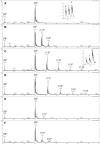Aminoglycosylation can enhance the G-quadruplex binding activity of epigallocatechin
- PMID: 23335983
- PMCID: PMC3545880
- DOI: 10.1371/journal.pone.0053962
Aminoglycosylation can enhance the G-quadruplex binding activity of epigallocatechin
Abstract
With the aim of enhancing G-quadruplex binding activity, two new glucosaminosides (16, 18) of penta-methylated epigallocatechin were synthesized by chemical glycosylation. Subsequent ESI-TOF-MS analysis demonstrated that these two glucosaminoside derivatives exhibit much stronger binding activity to human telomeric DNA and RNA G-quadruplexes than their parent structure (i.e., methylated EGC) (14) as well as natural epigallocatechin (EGC, 6). The DNA G-quadruplex binding activity of 16 and 18 is even more potent than strong G-quadruplex binder quercetin, which has a more planar structure. These two synthetic compounds also showed a higher binding strength to human telomeric RNA G-quadruplex than its DNA counterpart. Analysis of the structure-activity relationship revealed that the more basic compound, 16, has a higher binding capacity with DNA and RNA G-quadruplexes than its N-acetyl derivative, 18, suggesting the importance of the basicity of the aminoglycoside for G-quadruplex binding activity. Molecular docking simulation predicted that the aromatic ring of 16 π-stacks with the aromatic ring of guanine nucleotides, with the glucosamine moiety residing in the groove of G-quadruplex. This research indicates that glycosylation of natural products with aminosugar can significantly enhance their G-quadruplex binding activities, thus is an effective way to generate small molecules targeting G-quadruplexes in nucleic acids. In addition, this is the first report that green tea catechin can bind to nucleic acid G-quadruplex structures.
Conflict of interest statement
Figures








Similar articles
-
Mass spectrometric studies on effects of counter ions of TMPyP4 on binding to human telomeric DNA and RNA G-quadruplexes.Anal Bioanal Chem. 2014 Sep;406(22):5455-63. doi: 10.1007/s00216-014-7943-0. Epub 2014 Jun 18. Anal Bioanal Chem. 2014. PMID: 24939133 Free PMC article.
-
Recognition of chelerythrine to human telomeric DNA and RNA G-quadruplexes.Sci Rep. 2014 Oct 24;4:6767. doi: 10.1038/srep06767. Sci Rep. 2014. PMID: 25341562 Free PMC article.
-
DNA G-Quadruplex in Human Telomeres and Oncogene Promoters: Structures, Functions, and Small Molecule Targeting.Acc Chem Res. 2022 Sep 20;55(18):2628-2646. doi: 10.1021/acs.accounts.2c00337. Epub 2022 Sep 2. Acc Chem Res. 2022. PMID: 36054116 Free PMC article.
-
DNA and RNA quadruplex-binding proteins.Int J Mol Sci. 2014 Sep 29;15(10):17493-517. doi: 10.3390/ijms151017493. Int J Mol Sci. 2014. PMID: 25268620 Free PMC article. Review.
-
Interaction of G-quadruplexes with nonintercalating duplex-DNA minor groove binding ligands.Bioconjug Chem. 2011 Dec 21;22(12):2355-68. doi: 10.1021/bc200268a. Epub 2011 Nov 10. Bioconjug Chem. 2011. PMID: 22074555 Review.
Cited by
-
Targeting C-myc G-quadruplex: dual recognition by aminosugar-bisbenzimidazoles with varying linker lengths.Molecules. 2013 Nov 18;18(11):14228-40. doi: 10.3390/molecules181114228. Molecules. 2013. PMID: 24252993 Free PMC article.
-
Identification of new natural DNA G-quadruplex binders selected by a structure-based virtual screening approach.Molecules. 2013 Sep 30;18(10):12051-70. doi: 10.3390/molecules181012051. Molecules. 2013. PMID: 24084014 Free PMC article.
-
Mass spectrometric studies on effects of counter ions of TMPyP4 on binding to human telomeric DNA and RNA G-quadruplexes.Anal Bioanal Chem. 2014 Sep;406(22):5455-63. doi: 10.1007/s00216-014-7943-0. Epub 2014 Jun 18. Anal Bioanal Chem. 2014. PMID: 24939133 Free PMC article.
-
Quantitative analysis of the flavonoid glycosides and terpene trilactones in the extract of Ginkgo biloba and evaluation of their inhibitory activity towards fibril formation of β-amyloid peptide.Molecules. 2014 Apr 10;19(4):4466-78. doi: 10.3390/molecules19044466. Molecules. 2014. PMID: 24727418 Free PMC article.
-
Bioactive nutraceuticals as G4 stabilizers: potential cancer prevention and therapy-a critical review.Naunyn Schmiedebergs Arch Pharmacol. 2024 Jun;397(6):3585-3616. doi: 10.1007/s00210-023-02857-z. Epub 2023 Nov 29. Naunyn Schmiedebergs Arch Pharmacol. 2024. PMID: 38019298 Review.
References
-
- Lipps HJ, Rhodes D (2009) G-quadruplex structures: in vivo evidence and function. Trends Cell Biol 19: 414–422. - PubMed
-
- Neidle S, Parkinson GN (2003) The structure of telomeric DNA. Curr Opin Struct Biol 13: 275–283. - PubMed
-
- Azzalin CM, Reichenbach P, Khoriauli L, Giulotto E, Lingner J (2007) Telomeric repeat containing RNA and RNA surveillance factors at mammalian chromosome ends. Science 318: 798–801. - PubMed
Publication types
MeSH terms
Substances
LinkOut - more resources
Full Text Sources
Other Literature Sources
Research Materials
Miscellaneous

